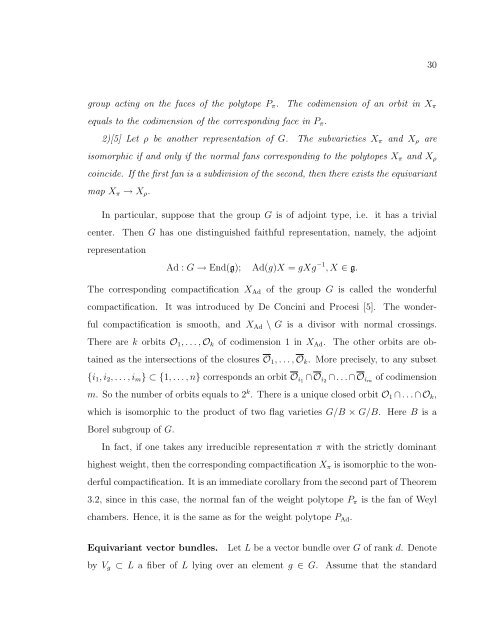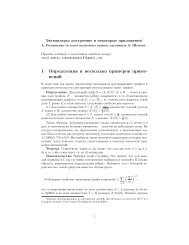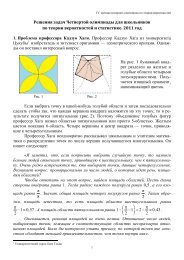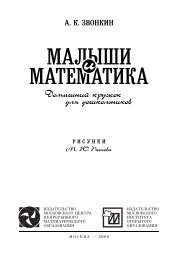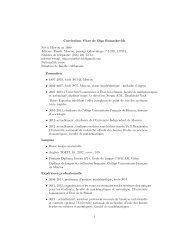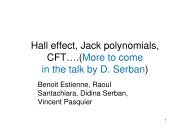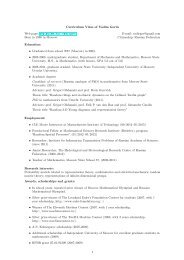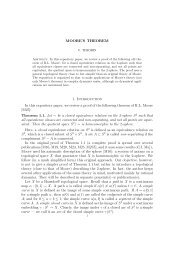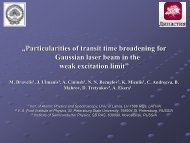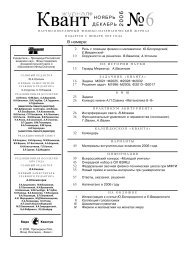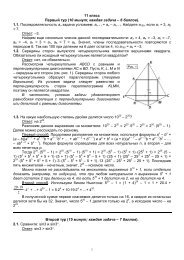a gauss-bonnet theorem, chern classes and an adjunction formula
a gauss-bonnet theorem, chern classes and an adjunction formula
a gauss-bonnet theorem, chern classes and an adjunction formula
Create successful ePaper yourself
Turn your PDF publications into a flip-book with our unique Google optimized e-Paper software.
30<br />
group acting on the faces of the polytope P π . The codimension of <strong>an</strong> orbit in X π<br />
equals to the codimension of the corresponding face in P π .<br />
2)[5] Let ρ be <strong>an</strong>other representation of G. The subvarieties X π <strong><strong>an</strong>d</strong> X ρ are<br />
isomorphic if <strong><strong>an</strong>d</strong> only if the normal f<strong>an</strong>s corresponding to the polytopes X π <strong><strong>an</strong>d</strong> X ρ<br />
coincide. If the first f<strong>an</strong> is a subdivision of the second, then there exists the equivari<strong>an</strong>t<br />
map X π → X ρ .<br />
In particular, suppose that the group G is of adjoint type, i.e. it has a trivial<br />
center. Then G has one distinguished faithful representation, namely, the adjoint<br />
representation<br />
Ad : G → End(g); Ad(g)X = gXg −1 , X ∈ g.<br />
The corresponding compactification X Ad of the group G is called the wonderful<br />
compactification. It was introduced by De Concini <strong><strong>an</strong>d</strong> Procesi [5]. The wonderful<br />
compactification is smooth, <strong><strong>an</strong>d</strong> X Ad \ G is a divisor with normal crossings.<br />
There are k orbits O 1 , . . . , O k of codimension 1 in X Ad . The other orbits are obtained<br />
as the intersections of the closures O 1 , . . . , O k . More precisely, to <strong>an</strong>y subset<br />
{i 1 , i 2 , . . . , i m } ⊂ {1, . . . , n} corresponds <strong>an</strong> orbit O i1 ∩ O i2 ∩ . . . ∩ O im of codimension<br />
m. So the number of orbits equals to 2 k . There is a unique closed orbit O 1 ∩ . . . ∩ O k ,<br />
which is isomorphic to the product of two flag varieties G/B × G/B. Here B is a<br />
Borel subgroup of G.<br />
In fact, if one takes <strong>an</strong>y irreducible representation π with the strictly domin<strong>an</strong>t<br />
highest weight, then the corresponding compactification X π is isomorphic to the wonderful<br />
compactification. It is <strong>an</strong> immediate corollary from the second part of Theorem<br />
3.2, since in this case, the normal f<strong>an</strong> of the weight polytope P π is the f<strong>an</strong> of Weyl<br />
chambers. Hence, it is the same as for the weight polytope P Ad .<br />
Equivari<strong>an</strong>t vector bundles.<br />
Let L be a vector bundle over G of r<strong>an</strong>k d. Denote<br />
by V g ⊂ L a fiber of L lying over <strong>an</strong> element g ∈ G. Assume that the st<strong><strong>an</strong>d</strong>ard


